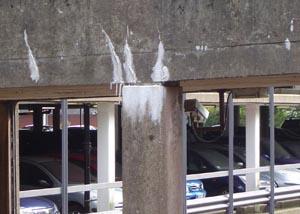Peter Borrows takes us on another excursion into local chemistry. In this issue: concrete stalactites
Have you ever seen a concrete stalactite, ie a stalactite that has formed spontaneously on concrete, rather than on limestone rock? Look up as you walk under a concrete bridge or flyover. Very likely you will spot stalactites hanging down from the roof. These are formed by much the same chemistry as makes lime water go milky in the familiar school experiment so it is easy to relate concrete stalactites to ideas that pupils will know.

Concrete chemistry
Concrete is formed from cement, which in turn is made by roasting limestone with clay. The chemistry is summarised in equations (i) and (ii).
3CaCO3 (s) + Al4 Si4 O10 (OH)8 (s) → Ca3 SiO5 (s) + Al4 Si3 O12 (s) + 4H2 O(g) + 3CO2 (g) (i)
CaCO3 (s) → CaO(s) + CO2 (g) (ii)
The cement is then mixed with sand and water to form concrete. The concrete sets because the calcium oxide reacts with carbon dioxide (equation (iii)), especially at and near the surfacewhere there is abundant carbon dioxide.
CaO(s) + CO2 (g) → CaCO3 (s) (iii)
However, some unreacted calcium oxide from reaction (ii) will remain in the body of the concrete. As water slowly seeps through the concrete the calcium oxide reacts to form the hydroxide and then a solution of the hydroxide - ie lime water.
CaO(s) + H2 O(l) → Ca(OH)2 (aq) (iv)
As with laboratory lime water, the calcium hydroxide solution reacts when exposed to the air, forming calcium carbonate - the stalactite.
Ca(OH)2 (aq) + CO2 (g) → CaCO3 (s) + H2 O(l) (v)
So concrete stalactites form where rain water can percolate through the concrete. Occasionally, even the mortar between bricks is sufficient to generate a stalactite.
Urban dripstone
The dripping liquid is a more or less saturated solution of calcium hydroxide, and will be quite strongly alkaline. Check some of the drips with Universal Indicator paper, the pH will come out at 10 or 11. These stalactites grow much faster than those in caves, where growth rates of 1 cm in 1000 years are typical. I have measured the growth rate of some concrete stalactites at about 1 cm per year and lengths in excess of 10 cm are quite common.
On the ground below where the drips form you will often see a white patch - the beginnings of a stalagmite. These tend to get damaged by people walking on them and rarely form more than a faint but broad 1 cm high bump. As with cave stalactites, the concrete ones are often discoloured, usually brown or yellow as a result of the presence of iron, possibly from the reinforcing rods in the concrete.









1 Reader's comment